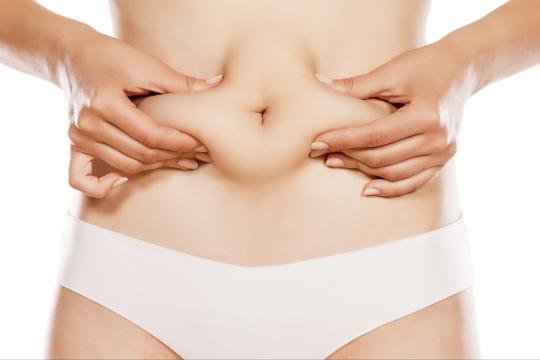
After the birth of my second child who was delivered via C-section, I was left with a small but noticeable area of extra skin which, despite my best efforts to minimize, I have not been able to improve. That sweet baby boy, the one who just refused to get into position in-utero, is now 11 years old and lovingly tells me he is “so sorry that my tummy has a flap that hangs over.” I have finally come to accept the cold hard fact that without a true tummy tuck I will never be able to wear a bikini again. So I’ve been doing a bit of research and was surprised to learn that there are many variations on this surgery and i thought Toronto-based board-certified plastic surgeon, Dr. Marc DuPéré could enlighten me on the many techniques that are available to help me (and other women who are in the same boat) navigate just which tummy tuck surgical procedure is the best one for them.
So what is a tummy tuck?
“A tummy-tuck, AKA abdominoplasty, is a powerful and gratifying procedure to remove excess fat and soft tissue in the lower abdomen area, often after pregnancies or serious weight loss,” says Dr. DuPéré. “Most types aim at repairing the stretched inner muscles (rectus muscles or the so-called 6-abs muscle) and restoring the silhouette. The belly-button is often resized and rejuvenated.”
Dr. DuPéré says the kind of tummy-tuck he suggests to his patients depends on several factors. These include: their anatomy, the quality of their abdominal muscles and skin, their obstetric and/or weight loss/gain history, the amount of recovery time they can afford and whether or not they smoke, have diabetes or other medical conditions affecting their blood flow. He shares several different types of tummy tucks to suit a variety of body types.
The ‘classic’ or full version of the tummy tuck, according to Dr. DuPéré, is an incision from one ASIS (anterior superior iliac spine) to the other – ASIS being the bony prominences at the beginning of each of the love handles. It will address the entire front of the abdomen, the muscle tightening and the belly-button resizing.
The extended version tummy tuck is when the patient has side rolls extending into the lower back rolls area. The incision is much longer and is reserved for overweight patients where classic tummy-tucks would leave him/her with the rolls on the side, something most patients do not like – so it will excise the “side rolls.”
Dr. DuPéré notes that there is an even longer version of the tummy tuck which is done when someone has lost a serious amount of weight, (within the 100-200 lb. range). A circumferential excision is done – also referred to as a body lift – which is a combination of the extended tummy-tuck with a buttock lift, often with buttock auto-augmentation with the normally discarded fat.
The mini-tummy-tuck has a smaller incision, slightly longer than a C-section scar, reserved for small ladies with excess of skin mostly under the belly-button. It addresses the area below the belly-button, i.e. the loose muscle and excess of skin, but it is more difficult with this technique to address the upper abdomen should it require extensive tightening. In most mini-tummy-tucks the belly-button is “floated” instead of reshaped/resized, otherwise, the patient may be left with a small vertical scar.
So where does Liposuction fit into the tummy tuck equation?
“Liposuction is not always necessary, but I must say most of my patients will benefit from it. Most of my plastic surgery procedures – neck lift, breast lift, arm lift, body lift, etc. – have a component of liposuction for shaping and contouring,” says Dr. DuPéré. “Liposuction will help achieve the hourglass shape in ladies – or the masculine triangle of the male’s torso – by reaching the upper abdomen, the love handles and the lower back rolls.”
According to Dr. DuPéré liposuction should be done carefully and safely, and by board-certified plastic surgeons, as liposuction itself has its own risks. There are even some restrictions depending on the states the patients live in.
“Our restrictions in Toronto are that it should be performed by a board-certified plastic surgeon in an accredited surgical facility, with board-certified anesthesiologists and no more than 5000ml of aspirate in one setting, likely less so when combined with other body procedures,” says Dr. DuPéré. “Also, many patients will add liposuction to bra rolls, inner knees and outer thighs. For larger volumes of liposuction combined with tummy-tucks, I like to keep my patients overnight for observation with fluid and pain management.”
All that being said, there are some limitations of the tummy tuck, cautions Dr. DuPéré.
“A tummy-tuck will not address the fat that is INSIDE the abdomen and around the internal organs - something many males do have as we get older; this is best addressed with diet and exercise,” says Dr DuPéré. “A tummy-tuck can help with very small ventral or umbilical hernias but larger hernias need to be addressed first by a general surgeon.”
Are there side effects?
The side effects and risks one should be aware of when getting a tummy tuck are scarring, bruising and swelling. You will need a minimum of two to three weeks for recovery. Rarer issues are hematomas (accumulation of blood) and seroma (accumulation of clear fluids), infection, wound opening and skin healing issues notably with smokers.
Lastly and much rarer, clots in the legs and embolism of clot or fat to the lungs. To minimize these complication risks, all tummy-tucks should be done by board-certified plastic surgeons with board-certified anesthesiologists in an accredited surgical center. Care should be given for proper intraoperative volume management and DVT (deep venous thrombosis i.e. clots) prevention. Overnight stay should be considered for patients who have had larger procedures.
When it comes to procedures and ways to avoid a potential tummy tuck, Dr. DuPéré says the best is always diet and exercise, as unfortunately the non-invasive procedures have very limited success and smaller-scale results (better for patients who are looking to lose an inch or two but not considerable volume).
As far as I’m concerned, Dr. DuPéré has proven one very salient point - that one tummy tuck does not fit all sizes! So if you are ready to go under the scalpel - it is wise to take his advice into consideration when choosing a prospective surgeon to perform your procedure - one who will tailor it to fit your needs and body type.
According to Real Patient Ratings, a tummy tuck has a 96% patient satisfaction rating. To hear about another patient’s experience, watch this clip.




